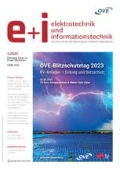Zusammenfassung
Ein neuartiges miniaturisiertes Analysesystem zur quantitativen Zellanalyse, auf Basis dielektrischer Mikrosensoren und Mikrofluidik, wird in dieser Arbeit vorgestellt. Das realisierte Lab-on-a-Chip beinhaltet in Kammern eingebettete, passivierte interdigitale Elektrodensysteme. Die Einführung einer Multilagen-Passivierung ermöglicht, im Gegensatz zu herkömmlichen Bioimpedanz-Systemen, die Isolation und somit die räumliche Trennung der dielektrischen Mikrosensoren von der Flüssigkeitsumgebung in den Analysekammern. Anhand von unterschiedlichen, in vitro cultivated cells. The overall performance of the system is demonstrated on various bacterial and yeast strains. Due to the high sensitivity of the contact-less dielectric microsensors it is possible to directly identify microbial strains, based on morphological differences and biological composition in the absence of any indicators or labels. Additionally, dielectric changes occurring in sub-cellular structures such as membranes can be directly monitored over a wide frequency range. As a result, microfluidic biochips are developed to continuously monitor cell morphology changes in a non-invasive manner over long periods of time.
Summary
In the presented work we describe the novel combination of contact-less dielectric microsensors and microfluidics for quantitative cell analysis. The lab-on-a-chip system consists of microfluidic channels and chambers together with integrated and passivated interdigitated electrode structures. In contrast to existing bioimpedance methods implemented for cell analysis, the dielectric microsensors are completely insulated and physically removed from the liquid sensing environment using defined multi-passivation layer of distinct size and composition. Consequently, these structures act as contact-less microsensors for the characterization of in vitro kultivierten, Bakterien und Hefezellen wird das Lab-on-a-Chip charakterisiert. Es zeigt sich, dass mikrobiologische Substanzen aufgrund morphologischer Unterschiede bzw. ihrer biologischen Zusammensetzung ohne Verwendung von Markern oder Indikatoren identifiziert werden können. Dielektrische Variationen in subzellularen Strukturen, wie beispielsweise der Membranen, sind über einen weiten Messfrequenzbereich beobachtbar. Der präsentierte mikrofluidische Biochip wurde speziell für die kontinuierliche und nicht-invasive Beobachtung der Zellmorphologie über lange Zeiträume entwickelt.
References
Arndt, S., Seebach, J., Psathaki, K., Galla, H. J., Wegener, J. (2004): Bioelectrical impedance assay to monitor changes in cell shape during apoptosis. Biosens. Bioelectron., 19 (6): 583–594
Asami, K. (2002): Characterization of biological cells by dielectric spectroscopy. J. Non-Crystal. Solids., 305 (1–3): 268–277
Auroux, P. A., Iossifidis, D., Reyes, D. R., Manz, A. (2002): Micro total analysis systems. 2. Analytical standard operations and applications. Anal. Chem., 74 (12): 2637–2652
Bard, A. J., Faulkner, L. R. (2001): Electrochemical methods. 2 ed. New York: John Wiley & Sons
Breslauer, D. N., Lee, P. J., Lee, L. P. (2006): Microfluidics-based systems biology. Molecul. Biosys., 2 (2): 97–112
Ciambrone, G. J., Liu, V. F., Lin, D. C., McGuinness, R. P., Leung, G. K., Pitchford, S. (2004): Cellular dielectric spectroscopy: a powerful new approach to label-free cellular analysis. J. Biomolecul. Screen., 9 (6): 467–480
Coates, A. R. M. (2003): Dormancy and low-growth states in microbial disease. Cambridge University Press, Cambridge
Ehret, R., Baumann, W., Brischwein, M., Schwinde, A., Wolf, B. (1998): On-line control of cellular adhesion with impedance measurements using interdigitated electrode structures. Med. Biol. Eng. Comput., 36 (3): 365–370
Gerwen, P. V., Laureyn, W., Laureys, W., Huyberechts, G. M., De Beeck, O., Baert, K., Suls, J., Sansen, W., Jacobs, P., Hermans, L., Mertens, R. (1998): Nanoscaled interdigitated electrode arrays for biochemical sensors. Sens. Act. B, 49: 73
Giaever, I., Keese, C. R. (1984): Monitoring fibroblast behavior in tissue culture with an applied electric field. Proc. Nat. Acad. Sci. USA, 81: 3761–3764
Gomez, R., Bashir, R., Bhunia, A. K. (2002): Microscale electronic detection of bacterial metabolism. Sens. Act. B-Chem., 86 (2–3): 198–208
Harrison, D. J., Manz, A., Fan, Z. H., Ludi, H., Widmer, H. M. (1992): Capillary electrophoresis and sample injection systems integrated on a planar Glass Chip. Anal. Chem., 64 (17): 1926–1932
Igreja, R., Dias, C. J. (2004): Analytical evaluation of the interdigital electrodes capacitance for a multi-layered structure. Sens. Act. A-Physical, 112 (2–3): 291–301
Ionescu-Zanetti, C., Shaw, R. M., Seo, J. G., Jan, Y. N., Jan, L. Y., Lee, L. P. (2005): Mammalian electrophysiology on a microfluidic platform. Proc. Nat. Acad. Sci. USA, 102 (26): 9112–9117
Mamishev, A. V., Sundara-Rajan, K., Yang, F., Du, Y. Q., Zahn, M. (2004): Interdigital sensors and transducers. Proc. IEEE., 92 (5): 808–845
Markx, G. H., Davey, C. L. (1999): The dielectric properties of biological cells at radiofrequencies: applications in biotechnology, Enzy. Microbiol. Technol., 25 (3–5): 161–171
Polevaya, Y., Ermolina, I., Schlesinger, M., Ginzburg, B. Z., Feldman, Y. (1999): Time domain dielectric spectroscopy study of human cells-II. Normal and malignant white blood cells. Biochimica Et Biophysica Acta-Biomembranes, 1419 (2): 257–271
Prodan, C., Mayo, F., Claycomb, J. R., Miller, J. H., Benedik, M. J. (2004): Low-frequency, low-field dielectric spectroscopy of living cell suspensions, J. Appl. Phys., 95 (7): 3754–3756
Richter, L., Stepper, C., Mak, A., Reinthaler, A., Heer, R., Kast, M., Brueckl, H., Ertl, P. (2007): Development of a microfluidic biochip for online monitoring of fungal biofilm dynamics. Lab Chip, 7: 1723–1731
Storz, G., Hengge-Aronis, R. (2000): Bacterial Stress Responses. Washington D.C.: ASM Press
Suehiro, J., Hamada, R., Noutomi, D., Shutou, M., Hara, M. (2003): Selective detection of viable bacteria using dielectrophoretic impedance measurement method. J. Electrostat., 57 (2): 157–168
Takashima, S. (1989): Electrical properties of biopolymers and membranes. Bristol: Adam Hilger
Vilkner, T., Janasek, D., Manz, A. (2004): Micro total analysis systems. Recent developments. Anal. Chem., 76 (12): 3373–3385
Whitesides, G. M. (2003): The 'right' size in nanobiotechnology. Nat. Biotechn., 21 (10): 1161–1165
Yardley, Y. E., Kell, D. B., Barrett, J., Davey, C. L. (2000): On-line, real-time measurements of cellular biomass using dielectric spectroscopy. In: Biotechnology and Genetic Engineering Reviews, Vol. 17. Andover: Intercept Ltd Scientific, Technical & Medical Publishers: pp. 3–35
Yeon, J. H., Park, J. K. (2005): Cytotoxicity test based on electrochemical impedance measurement of HepG2 cultured in microfabricated cell chip. Anal. Biochem., 341 (2): 308–315
Author information
Authors and Affiliations
Rights and permissions
About this article
Cite this article
Ertl, P., Heer, R. Interdigitated impedance sensors for analysis of biological cells in microfluidic biochips. Elektrotech. Inftech. 126, 47–50 (2009). https://doi.org/10.1007/s00502-009-0607-7
Received:
Accepted:
Issue Date:
DOI: https://doi.org/10.1007/s00502-009-0607-7

